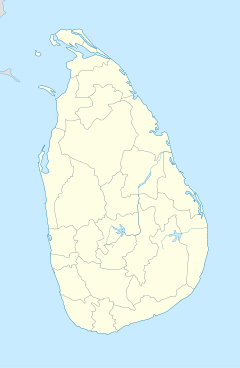- Nallur Kandaswamy temple
-
Nallur Kandaswamy temple 
Entrance to the Nallur Kandaswamy Kovil in Jaffna, Sri Lanka.Coordinates: 9°40′28.82″N 80°1′46.61″E / 9.6746722°N 80.0296139°ECoordinates: 9°40′28.82″N 80°1′46.61″E / 9.6746722°N 80.0296139°E Name Proper name: Nallur Kandaswamy Kovil Location Country: Sri Lanka Province: Northern District: Jaffna Architecture and culture Primary deity: Lord Murugan Architectural styles: Dravidian Architecture History Date built:
(Current structure)1749 Creator: Krishna Suba Iyer and Ragunatha Maapaana Mudaliyar Nallur Kandaswamy Kovil or Nallur Murugan Kovil (Tamil: நல்லூர் கந்தசுவாமி கோவில்) is one of the most significant Hindu temples in the Jaffna District of Northern Province, Sri Lanka. It stands in the town of Nallur. The presiding deity is Lord Muruga in the form of the holy Vel. The idol of the Nallur Devi or goddess was gifted to the temple in the 10 century CE by the Chola queen Sembiyan Mahadevi, in the style of Sembian bronzes.
Contents
Origins
The Nallur Kandaswamy Temple foundation year was 948 CE. According to the Yalpana Vaipava Malai, the temple was developed at the site in the 13th century by Puvenaya Vaku, a minister to the Jaffna King Kalinga Magha. Sapumal Kumaraya (also known as Chempaha Perumal in Tamil), who ruled the Jaffna kingdom on behalf of the Kotte kingdom is credited with either building or renovating the third Nallur Kandaswamy temple.[1][2] Nallur served as the capital of the Jaffna kings, with the royal palace situated very close to the temple. Nallur was built with four entrances with gates.[3] There were two main roadways and four temples at the four gateways.[3]
The rebuilt temples that exist now do not match their original locations which instead are occupied by churches erected by the Portuguese.[3] The center of the city was Muthirai Santhai (market place) and was surrounded by a square fortification around it.[3] There were courtly buildings for the kings, Brahmin priests, soldiers and other service providers.[3] The old Nallur Kandaswamy temple functioned as a defensive fort with high walls.[3] In general, the city was laid out like the traditional temple town according to Hindu traditions.[3] Cankilian Thoppu, the facade of the palace of King Cankili II, can still be found in Nallur.[4] The third temple was destroyed by the Portuguese Catholic colonial Phillippe de Oliveira in 1624 CE.
Current temple
The fourth and the present temple was constructed in 1749 A.D. during the benign Dutch colonial era by Krishna Suba Iyer and Ragunatha Maapaana Mudaliyar in the 'Kurukkal Valavu', which is the original temple premises.
Initially the temple was built using bricks and stones and had a cadjaned roof. The original shrine had only two main halls and didn't have a clock tower, surrounding courtyard, enclosing wall, or any ornately carved towers or gopuram.
The first clock tower was erected in 1899, and the main hall where the vel or lance of the deity resides was re-furbished using rocks in 1902. The first enclosing wall was erected in 1909. Likewise, the temple has been gradually renovated from time to time with contributions from the general public. In 1964, the 'Vasantha Mandapam' or grand hall was renovated to have the present look and feel.
The temple has the main entrance facing the east. It has an ornately carved five-story tower or gopuram in the Dravidian architecture style at the main entrance.
In the surrounding inner yard, it has shrines for Lords Ganesh, Vairavar, Sun and Sandana Gopala. In the southern part of this temple, the holy pond and Thandayudhapaani shrine dedicated to another aspect of Lord Muruga can be seen. In the northern side there is a big holy garden.
An underground locked cellar of the temple was found to contain several Chola bronzes from the 10th century CE gifted to the shrine.
Social significance
The temple is a socially important institution for the Sri Lankan Tamils Hindu identity of north Sri Lanka. In the Sri Lankan Tamil diaspora, many temples have been built in Europe and North America using the same name as a cultural memory.
There was a shrine dedicated to an Islamic sufi saint in the temple complex from 1734 to 1749 when the temple was built. The dargah was relocated in 1749 when the temple structure was built.[5]
New Gorpuram construction
On 21 August 2011 the temple unveiled its new 100-foot Gorpuram at 7:00am local time.
Festivals
The temple hosts the annual Temple car festival.
Thaipusam is an annual religious event celebrated by Hindus to commemorate the victory of Lord Murugan over the demon, Tarakasuran. Devotees and penitents can seen bearing kavadis and piercing their bodies with hooks and spears without seeming to cause any pain or harm, as an act of faith and atonement.
Gallery
Nallur Kandaswamy Temple Gallery See also
References
- ^ Peebles, History of Sri Lanka, p. 34
- ^ Gnanaprakasar, S A critical history of Jaffna, p. 103
- ^ a b c d e f g "Nallur Rajadhani: City Layout". V.N.Giritharan. http://www.geotamil.com/ctamils/forward_nallur.html. Retrieved 2007-12-02.
- ^ Kunarasa, K The Jaffna Dynasty, p. 4
- ^ Nallur Kumaran - a spiritual experience
External links
- Nallur Murukan Temple
- Nallur Murukan Temple's web
- Nalluran.Com
- Site about Nallur as the capital city of Jaffna Kingdom
- Nallur Chariot Festival
- Nallur Kandaswamy Kovil in 3D view requires silverlight
Hindu temples in Sri Lanka Ati Konanayakar • Kathirkamam • Ketheeswaram • Koneswaram • Maviddapuram • Munneswaram • Naguleswaram • Nainativu Nagapooshani Amman • Nallur Murugan • Pathirakali Amman • Tantontriswaram • Tenavaram • Thirukovil Murugan • VallipuramMurugan temples Palani · Thiruchendur · Swamimalai · Thiruthani · Pazhamudircholai · Thiruparamkunram · Subramanya · Marudamalai · Chennimalai · Thindalmalai · Sikkal · Vayalur · Viralimalai · Kunrakudy · Malai Mandir · Nallur · Maviddapuram · Batu Caves · Brickfields · KathirkamamCategories:- 948 establishments
- Hindu temples in Sri Lanka
- Buildings and structures in Jaffna
Wikimedia Foundation. 2010.





